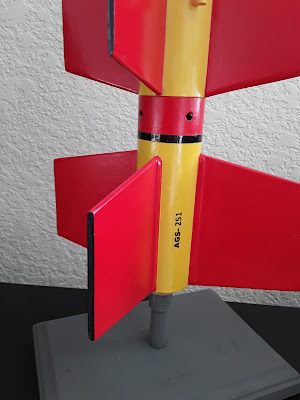Great weather conditions in Castle Rock this past Monday marked the first group launch of 2023 among members of our ever-growing Front Range rocketry 'gang'.
This day I was joined at Founders Park by three of the latest folks to become part of our group: David Frey, his son Xander, both from Denver, and Mike Perreault from Castle Rock.
Mike started off the festivities with a picture-perfect launch of a Bullpup on B4-4 power.
This was Mike's first ever rocket launch, and he was rewarded with a straight-up boost and perfect parachute deployment and recovery!
Next up, David launched a B4 powered 'Nuke Dukem, actually a Loc-Precision Mini-Nuke, carrying an altimeter. The model flew well, but lost its nose cone. Booster and electronics were successfully recovered. The bird hit a respectable 487 feet.
 |
| David and Xander Frey launch the Nuke Dukem !! |
The model was later flown a second time. Here is David's description of that flight:
“Cruise Missile mode activated and went horizontal
just after leaving the launch rod. We saw it go toward the parking lot
where we heard the report of the ejection charge but it was not
recovered. Total loss. RIP Duke!”
My first flight of the day was made with an altimeter-laden Generic E2X. A B6-4 took it to 411 feet and a successful recovery.
By this time Mike had his Bullpup ready to go again. Carbon copy of the model's successful first flight!
My next flight went to the Estes Quark equipped with streamers attached to the fins.
The tiny bird turned in an amusing flight on A10-3T power.
 |
| Heads up, Mike...It's Right Behind You !!!! |
Speaking of tiny birds, David and Xander had brought along a small fleet of 3D printed Estes 220 Sprint models. All were flown on 1/2A mini motors.
The 'Der Little Red Maxine' 220 Sprint Lifts Off
Xander's 220 Sprint, the 'Lemon-Lime' caught at the moment of liftoff.
Mike Perreault and Xander Frey prepping the 220 Sprint 'Annoying Orange'.
Xander is new to the hobby, and off to a great start!
 |
| All set to go. |
This next bird is the first flight of Mike's 'Purple Haze', actually an Estes Patriot with an alternate paint scheme.

Flying on a B6-4 motor, the model turned in a great maiden flight.
The next bird out if my tote was the Satellite Interceptor clone.
Flying on a B6-4, the bird turned in a nice flight, but suffered a para-wad recovery. No landing damage except for a missing dowel antenna from one of the fins.
David and Xander Frey launched an experimental 3D print, scratch built Alpha III clone, dubbed the 'Banana Blast'.
 |
| Xander is shown here attaching the leads to the Banana Blast. |
 |
| Liftoff on an A8-3 !! |
This is Mike's third launch of the Bullpup. Another perfect run on a B6-4!
Mike launched his Purple Haze model on two more successful flights, both on C6-5 motors.
Here are pics of the liftoffs:
My final flight of the afternoon was made by a Big Bertha.
The model flew straight and high on a C6-5 motor. As it drifted down, I ran to try and catch it, but I lost visual of it against the sun and ended up sprinting way past its landing site!
Between this and Mike's previous successful Purple Haze launches, it has been firmly established that Founders Park is perfectly fine for C motor / BT- 60 sized birds. On the next outing, I'm inclined to try out a Big Daddy on a D motor.
All in all, it was a fun afternoon of model rocket flying. Between the four of us, we put up 16 flights. Not too shabby.
One final note: I have to give kudos to Mike Perreault. This was his first ever foray into model rocketry. Not only are his first models well-built and attractively finished, but his flight prep and techniques are top-notch, as attested by six nearly flawless launches and recoveries. His pre-flight range-safety check and countdown procedures rival the best of any Range Control Officer I've ever seen at any club launch. The man has definitely done his homework! If I didn't know better, I would swear that Mike is a long-time, well-seasoned veteran of the model rocketry hobby.
Cheers!


















































